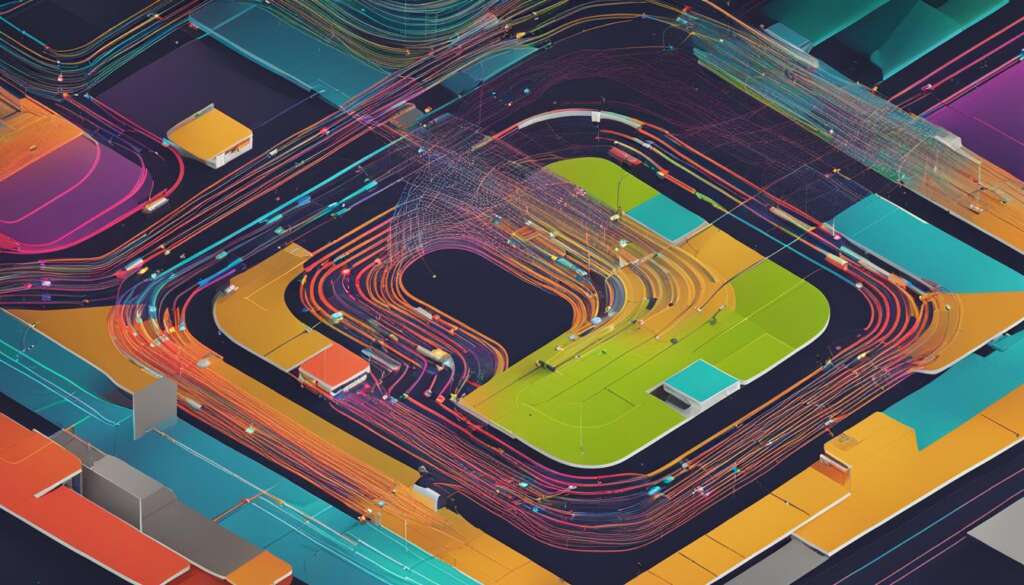Table of Contents
Welcome to our comprehensive guide on computer networks, where we explore the various types of networks, their infrastructure, data transmission, protocols, security, performance, management, topology, scalability, and troubleshooting. Computer networks have become an essential part of our daily lives, enabling seamless communication and resource sharing between devices.
Before we dive into the specifics, let’s take a moment to understand the importance of computer networks.
Personal Area Network (PAN)
A Personal Area Network (PAN) is a type of computer network that is centered around an individual’s workspace or personal devices. It is designed for short-range communication, typically within a range of 1 to 100 meters. PANs use various wireless technologies to enable connectivity between devices, such as Bluetooth, IrDA (Infrared Data Association), and Zigbee. These technologies allow for the seamless transfer of data and resources between PAN devices.
PAN devices can include a wide range of personal electronics, such as USB devices, computers, phones, tablets, printers, and PDAs (Personal Digital Assistants). These devices are equipped with the necessary PAN technologies to establish connections and exchange information within the network. For example, Bluetooth-enabled devices can easily connect and share data, while IrDA allows for infrared communication between devices without the need for cables or wires.
PANs offer individuals the convenience of having their personal devices interconnected, allowing for easy data sharing, file transfers, and device synchronization. Whether it’s wirelessly printing a document from a smartphone to a nearby printer or transferring files from a tablet to a computer, PANs provide a seamless and efficient way to connect and collaborate with personal devices.
PAN Devices:
| Device | Technology |
|---|---|
| USB | Bluetooth, IrDA, Zigbee |
| Computers | Bluetooth, IrDA, Zigbee |
| Phones | Bluetooth, IrDA, Zigbee |
| Tablets | Bluetooth, IrDA, Zigbee |
| Printers | Bluetooth, IrDA, Zigbee |
| PDAs | Bluetooth, IrDA, Zigbee |
https://www.youtube.com/watch?v=NLDtkQqvsmk
The Personal Area Network (PAN) offers individuals the convenience of having their personal devices interconnected, allowing for easy data sharing, file transfers, and device synchronization.
Local Area Network (LAN)
A Local Area Network (LAN) is a widely used type of computer network that connects computers within a limited area, such as a home, school, or office. LANs utilize Ethernet and Wi-Fi technologies to enable data transmission and communication between devices. With a range of up to 2km, LANs offer high-speed connectivity, easy maintenance, and cost-efficiency.
Advantages of LAN:
- High transmission speed: LANs provide fast data transfer rates, allowing for quick and efficient communication between connected devices.
- Easy maintenance: LANs are relatively simple to set up and maintain, making them an ideal choice for small-scale networks.
- Cost-effective: LAN infrastructure is generally affordable, making it accessible to individuals and organizations with budget constraints.
LAN Technologies:
LANs primarily utilize two key technologies:
- Ethernet: This wired technology uses cables to connect devices within the network, ensuring reliable and high-speed data transmission.
- Wi-Fi: LANs can also employ wireless technology, allowing devices to connect to the network without the need for physical cables, offering flexibility and convenience.
LANs are the foundation of many home and business networks. They provide a secure and efficient means of sharing resources, such as files, printers, and internet access, among connected devices.

LAN Table:
| Advantages | Ethernet | Wi-Fi |
|---|---|---|
| High Transmission Speed | ✓ | ✓ |
| Easy Maintenance | ✓ | ✓ |
| Cost-effective | ✓ | ✓ |
Campus Area Network (CAN)
A Campus Area Network (CAN) is a type of computer network that is commonly used in educational institutions and corporate campuses to connect multiple buildings within a defined area. It provides a reliable and efficient way of sharing resources and facilitating communication between different departments and locations within the campus.
CAN is primarily based on Ethernet technology, which offers high-speed data transmission over a local area. Ethernet cables are used to connect devices within each building, allowing for seamless connectivity and data sharing. With its range of 1 to 5 kilometers, CAN is designed to cover the entire campus area, ensuring that all buildings are interconnected.
One of the key advantages of CAN is its ability to provide high transmission speed, making it suitable for data-intensive tasks such as video streaming, large file transfers, and collaborative projects. Additionally, CAN offers moderate maintenance costs and is relatively affordable compared to other types of networks like Wide Area Networks (WAN).
Benefits of Campus Area Networks:
- Improved Collaboration: CAN enables seamless communication and collaboration between different departments and locations within the campus, fostering teamwork and enhancing productivity.
- Efficient Resource Sharing: With CAN, resources such as printers, servers, and databases can be shared across the campus, optimizing resource utilization and reducing costs.
- Scalability: CAN can easily accommodate the growth and expansion of a campus by adding additional buildings and network devices, making it a scalable solution for future needs.
In conclusion, Campus Area Networks (CAN) play a vital role in connecting multiple buildings within a campus, providing efficient communication and resource sharing. With its range of 1 to 5 kilometers, CAN offers high-speed data transmission and moderate maintenance costs. It promotes collaboration, enables efficient resource utilization, and can easily scale to accommodate future growth. Campus administrators and organizations alike can benefit from implementing a well-designed and robust CAN infrastructure to foster productivity and seamless connectivity.
| Advantages of CAN | Disadvantages of CAN |
|---|---|
| CAN enables seamless communication and collaboration within a campus. | Setting up and maintaining the infrastructure can require significant initial investment. |
| Resource sharing across the campus optimizes resource utilization. | System failures or network outages can impact connectivity and disrupt operations. |
| CAN offers high-speed data transmission for data-intensive tasks. | The limited range of CAN may not be suitable for larger campuses. |
| CAN is a scalable solution that can accommodate future growth. | Network security needs to be carefully managed to protect sensitive data. |
Metropolitan Area Network (MAN)
A Metropolitan Area Network (MAN) is a type of computer network that spans across a city or metropolitan area, connecting multiple locations and organizations within the region. MANs are designed to provide connectivity and data transmission between different local area networks (LANs) and wide area networks (WANs), enabling efficient communication and collaboration.
MANs employ various network technologies, including Fiber Distributed Data Interface (FDDI), Copper Distributed Data Interface (CDDI), and Asynchronous Transfer Mode (ATM). These technologies facilitate the transmission of data over longer distances, typically ranging from 5 to 50 kilometers. MANs are commonly used by businesses, government agencies, educational institutions, and other organizations that require network connectivity over a larger geographical area.
While MANs offer the advantage of connecting multiple locations within a city, they can be more challenging to maintain compared to LANs and PANs. The larger scale of a MAN requires careful network management and troubleshooting to ensure the smooth operation of the network. Additionally, the implementation and maintenance costs of MANs can be relatively high due to the need for specialized network infrastructure and equipment.
| Technology | Range |
|---|---|
| Fiber Distributed Data Interface (FDDI) | 5-50 kilometers |
| Copper Distributed Data Interface (CDDI) | 5-50 kilometers |
| Asynchronous Transfer Mode (ATM) | 5-50 kilometers |
In summary, a Metropolitan Area Network (MAN) is a network that connects multiple locations within a city or metropolitan area, using technologies such as FDDI, CDDI, and ATM. MANs facilitate efficient communication and data transmission over longer distances, but require careful management and can be costly to implement and maintain.
Wide Area Network (WAN)
A Wide Area Network (WAN) is a type of computer network that connects computers and devices over a large geographical distance through a shared communication path. WANs are essential for linking remote locations and enabling communication between them. The most common example of a WAN is the Internet, which connects computers and networks across the globe.
WANs utilize various technologies for data transmission, including Leased-Line and Dial-up connections. Leased-Line connections offer dedicated and continuous communication channels between two locations, providing a secure and reliable connection. Dial-up connections, on the other hand, establish temporary connections through telephone lines.
WANs have a range that extends beyond 50 kilometers, making them ideal for connecting distant sites. However, one important consideration is that WANs typically have lower transmission speeds compared to other types of networks. Additionally, WANs require high maintenance and can be costly to set up and maintain due to the need for specialized equipment and infrastructure.
| Advantages | Disadvantages |
|---|---|
|
|
Despite these challenges, the benefits of WANs, such as enabling global connectivity and facilitating remote access, make them indispensable in today’s interconnected world. The continuous advancements in technology and the increasing availability of high-speed Internet connections continue to enhance the capabilities and performance of WANs.
Key Points:
- Wide Area Networks (WANs) connect computers and devices over large geographical distances.
- WANs utilize technologies such as Leased-Line and Dial-up connections.
- WANs have a range beyond 50 kilometers and lower transmission speeds compared to other networks.
- Advantages of WANs include enabling communication between remote locations and supporting centralized management.
- Disadvantages of WANs include high maintenance costs and dependence on the reliability of the shared communication path.
Other Types of Computer Networks
In addition to the main types of computer networks, there are other specialized networks that cater to specific needs and requirements. These networks offer unique functionalities and play a crucial role in various industries and settings. Let’s explore some of these other types of computer networks:
Wireless Local Area Network (WLAN)
Wireless Local Area Network, commonly known as WLAN, is a type of network that utilizes Wi-Fi technology to connect devices without the need for physical cables. WLAN provides wireless connectivity within a limited area, such as a home, office, or public space. It offers flexibility and mobility, allowing users to access the network from different locations within the coverage area. WLAN is widely used in homes, businesses, and public areas to provide convenient and accessible internet connectivity.
Storage Area Network (SAN)
Storage Area Network, abbreviated as SAN, is a specialized network dedicated to providing high-speed access to storage devices. SAN allows multiple servers to access shared storage resources simultaneously. It enables efficient data storage, retrieval, and backup, making it ideal for organizations with large amounts of data. SAN is commonly used in data centers, enterprises, and organizations that require centralized storage management and high-performance data storage solutions.
System-Area Network (SAN)
System-Area Network, also known as SAN, is a network designed to connect high-performance computers and systems. SAN provides high-speed and low-latency communication between computing systems, enabling efficient data transfer and collaboration. It is commonly used in scientific research, high-performance computing, and other demanding applications that require fast and reliable network connections between systems.
Passive Optical Local Area Network (POLAN)
Passive Optical Local Area Network, or POLAN, is an alternative network architecture that utilizes passive optical splitters to provide connectivity within a limited area. POLAN eliminates the need for active networking equipment like switches, resulting in reduced power consumption and maintenance costs. It offers high bandwidth and scalability, making it suitable for settings where high-speed data transmission and cost efficiency are essential, such as commercial buildings and campuses.
Enterprise Private Network (EPN)
Enterprise Private Network, or EPN, is a network that connects multiple locations within an organization. EPN enables secure and private communication between branch offices, headquarters, and other company locations. It provides a reliable and efficient means of sharing resources, information, and services across different sites, promoting collaboration and seamless workflow. EPN is commonly implemented by businesses with multiple locations or remote offices that require a secure and interconnected network infrastructure.
Virtual Private Network (VPN)
Virtual Private Network, abbreviated as VPN, is a network that provides secure and encrypted connections over the internet. VPN allows users to access a private network remotely, ensuring data privacy and security. It is commonly used by individuals, businesses, and organizations to establish secure connections while accessing the internet or connecting to remote networks. VPNs are especially useful for remote workers, travelers, and those seeking to protect their online privacy and security.
Home Area Network (HAN)
Home Area Network, or HAN, is a network that interconnects multiple devices within a home. HAN allows devices such as computers, smartphones, smart appliances, and entertainment systems to communicate and share resources. It enables seamless integration and control of various smart devices, enhancing convenience, efficiency, and automation in the home environment. HAN is becoming increasingly popular with the rise of smart homes and the Internet of Things (IoT).
These other types of computer networks offer specialized capabilities and cater to specific needs in various settings. Whether it’s providing wireless connectivity, high-speed storage access, or secure communication, these networks play a crucial role in supporting modern technology infrastructure.
Advantages of Computer Networks
Computer networks have revolutionized the way we communicate and share information. The advantages of computer networks are numerous, and they play a crucial role in enhancing productivity and efficiency in both personal and professional settings.
One of the key advantages of computer networks is the central storage of data. With a network infrastructure in place, users can store and access their files and data from a central location, eliminating the need for individual devices to store the same data. This not only saves valuable storage space but also ensures that everyone has access to the latest and most up-to-date information.
Connectivity is another significant advantage of computer networks. By connecting devices together, networks enable seamless and instant communication between users. Whether it’s sending emails, sharing documents, or collaborating on projects, networks facilitate efficient and real-time communication, enhancing collaboration and teamwork.
“Computer networks provide the ability to share files and resources among connected devices, enabling seamless collaboration and improved productivity.”
Security through authorization is a critical advantage offered by computer networks. By implementing access control measures and user authentication protocols, networks ensure that only authorized individuals have access to sensitive information and resources. This helps protect against unauthorized access, data breaches, and potential security threats.

| Advantages of Computer Networks |
|---|
| Central Storage of Data |
| Connectivity |
| Sharing of Files |
| Security through Authorization |
Disadvantages of Computer Networks
While computer networks offer numerous advantages, they are not without their downsides. It is essential to be aware of the potential disadvantages in order to effectively manage and mitigate any risks that may arise.
One significant concern when it comes to computer networks is the risk of viruses and malware. The interconnected nature of networks makes them vulnerable to cyber threats. A single infected device can quickly spread malware to other connected devices, compromising sensitive data and disrupting network operations. Proactive measures, such as robust antivirus software and regular security updates, are necessary to protect against these threats.
Another drawback of computer networks is the high cost of setup and maintenance. Building a network infrastructure requires significant investment in hardware, software, and skilled personnel. Additionally, ongoing maintenance and upgrades can be costly, especially for larger networks. Organizations must carefully plan and budget for these expenses to ensure the network remains efficient and secure.
In the event of a system failure or network disruption, there is a risk of information loss. Without proper backup and disaster recovery measures in place, valuable data can be permanently damaged or lost. Data redundancy and regular backups are crucial to mitigate this risk and ensure the continuity of operations.
| Disadvantages of Computer Networks | Key Considerations |
|---|---|
| Virus and Malware | Implement robust security measures to protect against cyber threats. |
| High Cost of Setup | Plan and budget for the initial setup and ongoing maintenance expenses. |
| Loss of Information | Implement regular data backups and disaster recovery measures. |
Lastly, the management of a computer network can be complex and challenging. Network administrators must ensure the smooth operation of the network, addressing issues such as connectivity problems, network congestion, and performance optimization. It requires technical expertise, constant monitoring, and troubleshooting skills to maintain an efficient and reliable network.
Despite these disadvantages, the benefits of computer networks far outweigh the drawbacks, especially when they are properly managed and secured. Organizations can leverage network resources, enhance communication and collaboration, and improve overall efficiency. By understanding and addressing the potential challenges, organizations can harness the power of computer networks while mitigating risks effectively.
Conclusion
In conclusion, computer networks play a crucial role in today’s digital world. Understanding the different types of networks, their advantages, and disadvantages can help individuals and organisations make informed decisions about their network infrastructure.
From Personal Area Networks (PAN) to Wide Area Networks (WAN), each type of network offers unique capabilities and considerations. PANs are ideal for individuals, while LANs are commonly used in homes, schools, and offices. CANs connect multiple buildings within a campus, while MANs cover a city or metropolitan area. WANs, such as the Internet, connect computers over large geographical distances.
Computer networks offer various advantages, including central storage of data, easy connectivity between devices, sharing of files and resources, and enhanced security through authorization. These advantages contribute to efficient communication and collaboration within an organisation.
Despite their advantages, computer networks also have disadvantages. These include the risks of viruses and malware, the high cost of setup, the potential loss of information in case of system failure, and the complexity of managing a network. However, by effectively managing and securing computer networks, individuals and organisations can maximize network performance and ensure smooth data transmission and communication.
FAQ
What is a computer network?
A computer network is a cluster of computers over a shared communication path that works to share resources from one computer to another.
What are the main types of computer networks?
The main types of computer networks are Personal Area Network (PAN), Local Area Network (LAN), Campus Area Network (CAN), Metropolitan Area Network (MAN), and Wide Area Network (WAN).
What is a Personal Area Network (PAN)?
PAN is a network that is centered around an individual’s workspace, with a range of 1 to 100 meters. It uses technologies like Bluetooth, IrDA, and Zigbee.
What is a Local Area Network (LAN)?
LAN is the most frequently used network, connecting computers within a limited area, such as a home, school, or office. It uses Ethernet and Wi-Fi technologies, with a range of up to 2km.
What is a Campus Area Network (CAN)?
CAN is used in places like schools and colleges to connect multiple buildings within a campus. It mainly uses Ethernet technology with a range of 1 to 5 km.
What is a Metropolitan Area Network (MAN)?
MAN connects computers over a city or metropolitan area using technologies like FDDI, CDDI, and ATM. It has a range of 5 to 50 km.
What is a Wide Area Network (WAN)?
WAN connects computers over a large geographical distance through a shared communication path. It can cover a range above 50 km and uses Leased-Line and Dial-up technologies.
What are some other types of computer networks?
Some other types of computer networks include Wireless Local Area Network (WLAN), Storage Area Network (SAN), System-Area Network (SAN), Passive Optical Local Area Network (POLAN), Enterprise Private Network (EPN), Virtual Private Network (VPN), and Home Area Network (HAN).
What are the advantages of computer networks?
Computer networks offer advantages such as central storage of data, easy connectivity between devices, sharing of files and resources, and enhanced security through authorization.
What are the disadvantages of computer networks?
The disadvantages of computer networks include the risks of viruses and malware, the high cost of setup, the potential loss of information in case of system failure, and the complexity of managing a network.
Source Links
- https://www.simplilearn.com/tutorials/networking-tutorial/importance-of-types-of-networks-lan-man-wan
- https://www.geeksforgeeks.org/types-of-computer-networks/
- https://thrivenextgen.com/ten-types-of-computer-networks-an-easy-a-z-guide/













